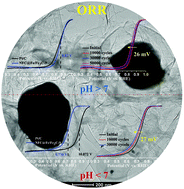Our official English website, www.x-mol.net, welcomes your
feedback! (Note: you will need to create a separate account there.)
A nitrogen and fluorine enriched Fe/Fe3C@C oxygen reduction reaction electrocatalyst for anion/proton exchange membrane fuel cells.
Nanoscale ( IF 5.8 ) Pub Date : 2020-01-14 , DOI: 10.1039/c9nr08631e Mohanraju Karuppannan 1 , Ji Eun Park 2 , Hyo Eun Bae 1 , Yong-Hun Cho 3 , Oh Joong Kwon 1
Nanoscale ( IF 5.8 ) Pub Date : 2020-01-14 , DOI: 10.1039/c9nr08631e Mohanraju Karuppannan 1 , Ji Eun Park 2 , Hyo Eun Bae 1 , Yong-Hun Cho 3 , Oh Joong Kwon 1
Affiliation

|
Nitrogen-doped carbon-encapsulated non-noble metals are promising electrocatalytic alternatives to Pt for the oxygen reduction reaction (ORR). Herein, we describe the efficient synthesis of nitrogen- and fluorine-doped carbon-encapsulated Fe/Fe3C (NFC@Fe/Fe3C) crystals from a Fe-poly(aniline-fluoro-aniline) co-polymer and demonstrate their use as efficient ORR electrocatalysts in acidic and alkaline environments. X-ray diffraction patterns, scanning electron microscopy, transmission electron microscopy, Raman spectra, and X-ray photoelectron spectroscopy are used to determine the structural properties of NFC@Fe/Fe3C. Of the NFC@Fe/Fe3C catalysts, NFC@Fe/Fe3C-9 demonstrates superior ORR electrocatalytic activity in both alkaline and acidic environments. NFC@Fe/Fe3C-9 follows a four-electron-transfer ORR pathway in alkaline and acidic media. Under alkaline conditions, NFC@Fe/Fe3C-9 displays a half-wave potential (E1/2) as 0.870 V, which is 16 mV higher than that of Pt/C, and its durability decay is 26 mV over 50 000 cycles. In acidic medium, the NFC@Fe/Fe3C-9 electrode shows inferior ORR performance than does Pt/C, but it is more durable, with only 27 mV decay over 30 000 cycles. A single cell performance of NFC@Fe/Fe3C-9 was tested with a proton-exchange membrane fuel cells (PEMFC) and an anion-exchange membrane fuel cell (AEMFC) with an active area of 5 cm2. The PEMFC single cell exhibits the maximum power density of 237 mW cm-2 with a back pressure of 250 kPa, while the AEMFC delivers a maximum power density of 96 mW cm-2 without back pressure.
中文翻译:

用于阴离子/质子交换膜燃料电池的富氮和氟的Fe / Fe3C @ C氧还原反应电催化剂。
氮掺杂的碳包封的非贵金属有望成为氧还原反应(ORR)的Pt的电催化替代品。在这里,我们描述了从Fe-聚(苯胺-氟-苯胺)共聚物中高效合成氮和氟掺杂的碳包裹的Fe / Fe3C(NFC @ Fe / Fe3C)晶体,并证明了它们作为有效的ORR的用途酸性和碱性环境中的电催化剂。X射线衍射图,扫描电子显微镜,透射电子显微镜,拉曼光谱和X射线光电子光谱用于确定NFC @ Fe / Fe3C的结构性质。在NFC @ Fe / Fe3C催化剂中,NFC @ Fe / Fe3C-9在碱性和酸性环境中均表现出优异的ORR电催化活性。NFC @ Fe / Fe3C-9在碱性和酸性介质中遵循四电子转移ORR途径。在碱性条件下,NFC @ Fe / Fe3C-9的半波电势(E1 / 2)为0.870 V,比Pt / C的半波电势高16 mV,在5万次循环中其耐久性衰减为26 mV。在酸性介质中,NFC @ Fe / Fe3C-9电极的ORR性能不如Pt / C,但更耐用,在3万次循环中仅衰减27 mV。使用质子交换膜燃料电池(PEMFC)和活性面积为5 cm2的阴离子交换膜燃料电池(AEMFC)测试了NFC @ Fe / Fe3C-9的单电池性能。PEMFC单电池在250 kPa背压下的最大功率密度为237 mW cm-2,而AEMFC在没有背压的情况下可提供96 mW cm-2的最大功率密度。在5万次循环中,其耐久性衰减为26 mV。在酸性介质中,NFC @ Fe / Fe3C-9电极的ORR性能不如Pt / C,但更耐用,在3万次循环中仅衰减27 mV。使用质子交换膜燃料电池(PEMFC)和活性面积为5 cm2的阴离子交换膜燃料电池(AEMFC)测试了NFC @ Fe / Fe3C-9的单电池性能。PEMFC单电池在250 kPa背压下的最大功率密度为237 mW cm-2,而AEMFC在没有背压的情况下可提供96 mW cm-2的最大功率密度。在5万次循环中,其耐久性衰减为26 mV。在酸性介质中,NFC @ Fe / Fe3C-9电极的ORR性能不如Pt / C,但更耐用,在3万次循环中仅衰减27 mV。使用质子交换膜燃料电池(PEMFC)和活性面积为5 cm2的阴离子交换膜燃料电池(AEMFC)测试了NFC @ Fe / Fe3C-9的单电池性能。PEMFC单电池在250 kPa背压下的最大功率密度为237 mW cm-2,而AEMFC在没有背压的情况下可提供96 mW cm-2的最大功率密度。使用质子交换膜燃料电池(PEMFC)和活性面积为5 cm2的阴离子交换膜燃料电池(AEMFC)测试了NFC @ Fe / Fe3C-9的单电池性能。PEMFC单电池在250 kPa背压下的最大功率密度为237 mW cm-2,而AEMFC在没有背压的情况下可提供96 mW cm-2的最大功率密度。使用质子交换膜燃料电池(PEMFC)和活性面积为5 cm2的阴离子交换膜燃料电池(AEMFC)测试了NFC @ Fe / Fe3C-9的单电池性能。PEMFC单电池在250 kPa背压下的最大功率密度为237 mW cm-2,而AEMFC在没有背压的情况下可提供96 mW cm-2的最大功率密度。
更新日期:2020-01-14
中文翻译:

用于阴离子/质子交换膜燃料电池的富氮和氟的Fe / Fe3C @ C氧还原反应电催化剂。
氮掺杂的碳包封的非贵金属有望成为氧还原反应(ORR)的Pt的电催化替代品。在这里,我们描述了从Fe-聚(苯胺-氟-苯胺)共聚物中高效合成氮和氟掺杂的碳包裹的Fe / Fe3C(NFC @ Fe / Fe3C)晶体,并证明了它们作为有效的ORR的用途酸性和碱性环境中的电催化剂。X射线衍射图,扫描电子显微镜,透射电子显微镜,拉曼光谱和X射线光电子光谱用于确定NFC @ Fe / Fe3C的结构性质。在NFC @ Fe / Fe3C催化剂中,NFC @ Fe / Fe3C-9在碱性和酸性环境中均表现出优异的ORR电催化活性。NFC @ Fe / Fe3C-9在碱性和酸性介质中遵循四电子转移ORR途径。在碱性条件下,NFC @ Fe / Fe3C-9的半波电势(E1 / 2)为0.870 V,比Pt / C的半波电势高16 mV,在5万次循环中其耐久性衰减为26 mV。在酸性介质中,NFC @ Fe / Fe3C-9电极的ORR性能不如Pt / C,但更耐用,在3万次循环中仅衰减27 mV。使用质子交换膜燃料电池(PEMFC)和活性面积为5 cm2的阴离子交换膜燃料电池(AEMFC)测试了NFC @ Fe / Fe3C-9的单电池性能。PEMFC单电池在250 kPa背压下的最大功率密度为237 mW cm-2,而AEMFC在没有背压的情况下可提供96 mW cm-2的最大功率密度。在5万次循环中,其耐久性衰减为26 mV。在酸性介质中,NFC @ Fe / Fe3C-9电极的ORR性能不如Pt / C,但更耐用,在3万次循环中仅衰减27 mV。使用质子交换膜燃料电池(PEMFC)和活性面积为5 cm2的阴离子交换膜燃料电池(AEMFC)测试了NFC @ Fe / Fe3C-9的单电池性能。PEMFC单电池在250 kPa背压下的最大功率密度为237 mW cm-2,而AEMFC在没有背压的情况下可提供96 mW cm-2的最大功率密度。在5万次循环中,其耐久性衰减为26 mV。在酸性介质中,NFC @ Fe / Fe3C-9电极的ORR性能不如Pt / C,但更耐用,在3万次循环中仅衰减27 mV。使用质子交换膜燃料电池(PEMFC)和活性面积为5 cm2的阴离子交换膜燃料电池(AEMFC)测试了NFC @ Fe / Fe3C-9的单电池性能。PEMFC单电池在250 kPa背压下的最大功率密度为237 mW cm-2,而AEMFC在没有背压的情况下可提供96 mW cm-2的最大功率密度。使用质子交换膜燃料电池(PEMFC)和活性面积为5 cm2的阴离子交换膜燃料电池(AEMFC)测试了NFC @ Fe / Fe3C-9的单电池性能。PEMFC单电池在250 kPa背压下的最大功率密度为237 mW cm-2,而AEMFC在没有背压的情况下可提供96 mW cm-2的最大功率密度。使用质子交换膜燃料电池(PEMFC)和活性面积为5 cm2的阴离子交换膜燃料电池(AEMFC)测试了NFC @ Fe / Fe3C-9的单电池性能。PEMFC单电池在250 kPa背压下的最大功率密度为237 mW cm-2,而AEMFC在没有背压的情况下可提供96 mW cm-2的最大功率密度。











































 京公网安备 11010802027423号
京公网安备 11010802027423号